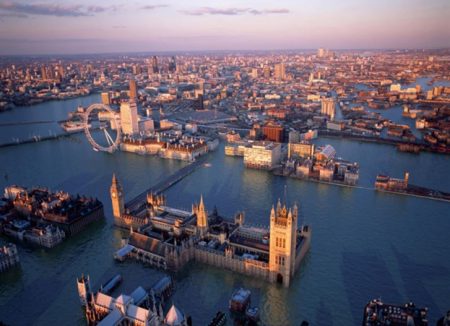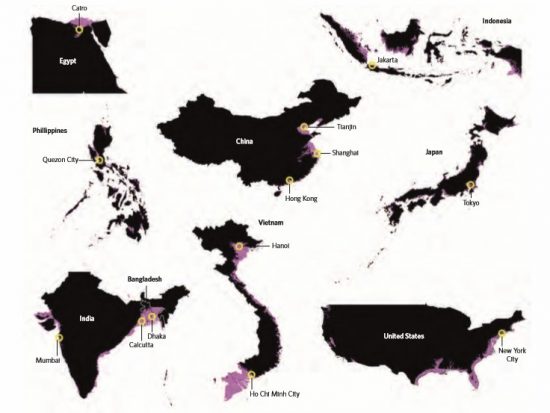November 21, 2016 – In a paper appearing in Nature Climate Change published last February, a research team presented the following: that the policy debate about anthropogenic climate change was being framed by data collected over the past 150 years. At the same time the projections on where climate change was taking us were largely viewed within a window ending in the year 2100. This was seen as extremely short-sighted.
The many authors of this study, including researchers from Oregon State, Boston College, University of Wisconsin, University of Victoria, Simon Fraser, Potsdam Institute and University, Columbia, University of Ottawa, University of Bern, Lawrence Livermore National Laboratory, Harvard, MIT, University of Chicago, Australian National University, Oxford University and others, argue that such a narrow perspective is a disservice to the science and to attendant policy development. Instead any legitimate science and policy derived from it needs to look at climate over the past 20 millennia and project the implications into the future.
State the authors, “This long-term perspective illustrates that policy decisions made in the next few years to decades will have profound impacts on global climate, ecosystems and human societies — not just for this century, but for the next ten millennia and beyond.
The paper describes the consensus within the scientific community that current and future carbon emissions will lead to a several degree rise in mean global temperatures by the end of the century. The paper also states that international response to this has, to date, been limited in scope. The authors believe that a contributing factor to the response we are seeing is based on the focus on the near-term up until 2100. This creates an impression that climate change is a 21st century problem and not one that will remain with us post-2100. This also leads to policy pronouncements focused on near-term impacts and that mitigation we do in the next few decades will negate climate change for the next millennia. With this limited perspective on anthropogenic climate change we are missing the bigger picture and we are also failing to understand climate change on a geological time scale. The authors argue that “the next few decades offer a brief window of opportunity to minimize large-scale and potentially catastrophic climate change that will extend longer than the entire history of human civilization thus far.” They further state that policy decisions made in this narrow window of time will change global climate for millennia to come
In the IPCC projections on climate change and its impacts there is little about the post-21st century. The IPCC reports tabled at annual COP gatherings gloss over what in a sense would be irreversible long-term climate change consequences. It is noted that emissions released in this century will still be around in the atmosphere in the year 3000 and that mean global temperatures and sea-level rise will also endure for the next 10,000 years.
How do we know this?
By studying palaeoclimates. These are the records we can draw from evidence over the last 20,000 years. In it we can reconstruct the more recent Ice Age and interglacial warming periods including the one in which we reside today. The period from the last glacial maximum approximately 21,000 years ago to the warming that began 11,700 years ago corresponds to changes in atmospheric carbon dioxide (CO2) from 190 to between 260 and 280 parts per million, a level that remained within those two latter numbers until the start of the Industrial Revolution. Since about 1900 we have seen CO2 levels rise at a pace that cannot be explained by geological observations. The variation that has happened since the turn of the 20th century is unprecedented in the last 21,000 years.
The study which has combined the palaeoclimate record with temperature projections for the next 10,000 years based on CO2 levels in the atmosphere are quite revealing. At current annual emission growth rates, approximately 2.5%, we have been witnessing a cumulative atmospheric carbon footprint that will see CO2 levels produce conditions exceeding even the warmest times in past interglacial periods. Projected warming at the low end will exceed 2.0 Celsius (3.6 Fahrenheit) and without significant carbon atmospheric reduction could rise as high as 7.0 Celsius (12.6 Fahrenheit).
The study looks at sea levels in the same way it addresses CO2 concentrations and temperature rise. Sea level change is determined by a number of factors. One is thermal expansion, a warm ocean increases in volume. A second is loss of land ice. A third is a decrease in land-water storage. Sea level rise is also affected by atmospheric dynamics and by deformation of continental surfaces as land ice melts. Even gravity and rotation can effect sea levels.
Studying the palaeo sea level record over the past 20,000 years gives us a better understanding of the relationship between atmospheric temperatures and oceans. About 20,000 years ago sea levels globally were on average 130 meters (426 feet) lower than today. The reason, enormous amounts of water contained in continental ice sheets. A rise in CO2 and accompanying rise in temperatures beginning 20,000 years ago led to a rise in sea levels to near-today levels 3,000 years ago. Atmospheric warming of a few degrees, therefore, caused a change of 130 meters in our oceans. More interesting is the fact that by 11,000 years ago we were already well into the interglacial warming period with stable CO2 levels as previously described. Yet the oceans continued to rise for the next 8,000 years by 45 meters (147 feet). This illustrates the latency effect of climate change on sea levels. Once can expect as our atmosphere warms to see this pattern continue through the next 10,000 years. The authors calculate that thermal expansion may be responsible for 1.1 meters (3.6 feet) over the next 2,300 years with a slow fall to 0.8 meters (2.6 feet) 10,000 years in the future. When we add alpine glaciers, Greenland’s ice sheets and the Antarctic, the potential sea level rise over the next 10,000 years could easily exceed 50 meters (164 feet). The more likely range of sea level rise from a partial melting of these land ice sources lies between 25 and 50 meters (82 to 164 feet). The rate of rise could exceed 4 meters (13.1 feet) per century and although not uniformly distributed across the entire planet, represents an unprecedented change for humanity.
The maps below show projected submerged areas in countries based on lower-base range sea level rise. The areas coloured purple represent places where wholesale populations will have to be removed. Large cities are indicated by yellow circles.
So what are the policy implications of this long-term view of climate change?
The authors ask, “Does placing the future of climate in the context of the past, emphasizing the long timescales in the climate system and the carbon cycle, lead to any specific actions or policies that differ from what the more common view of climate change over the current century already requires?”
Future generations will be impacted by the decisions we make in the near term and yet it is they who will be most profoundly impacted by what gets decided today. As scientists the authors state it is not their job to prescribe policy. It is not up to them to look at the equity, morality and ethics of policy options put in place in the near present.
But having said that they do point to the evidence drawn from palaeoclimate records that any policy must lead to a “new global energy system that has net-zero or net-negative CO2 emissions, and not simply….aimed at near-term emissions reductions.” A marginal reduction in emissions the authors state would be deemed insufficient to stop the damage.
What does a net-negative CO2 energy system entail?
It would be completely different from what we do today. The authors use a term created by others, the fourth industrial revolution, to describe it. It would be focused on decarbonization while addressing a sustainable system for future generations. Decarbonization calls for accelerated investment in technologies that completely disrupt our current energy generating infrastructure. It means accelerated deployment of carbon harvesting technology that captures CO2 and methane (CH4) and removes them as atmospheric gases and repurposes them in closed-cycle systems or sequesters them permanently, restoring the carbon balance that existed 11,000 years ago and up until about 1900.













